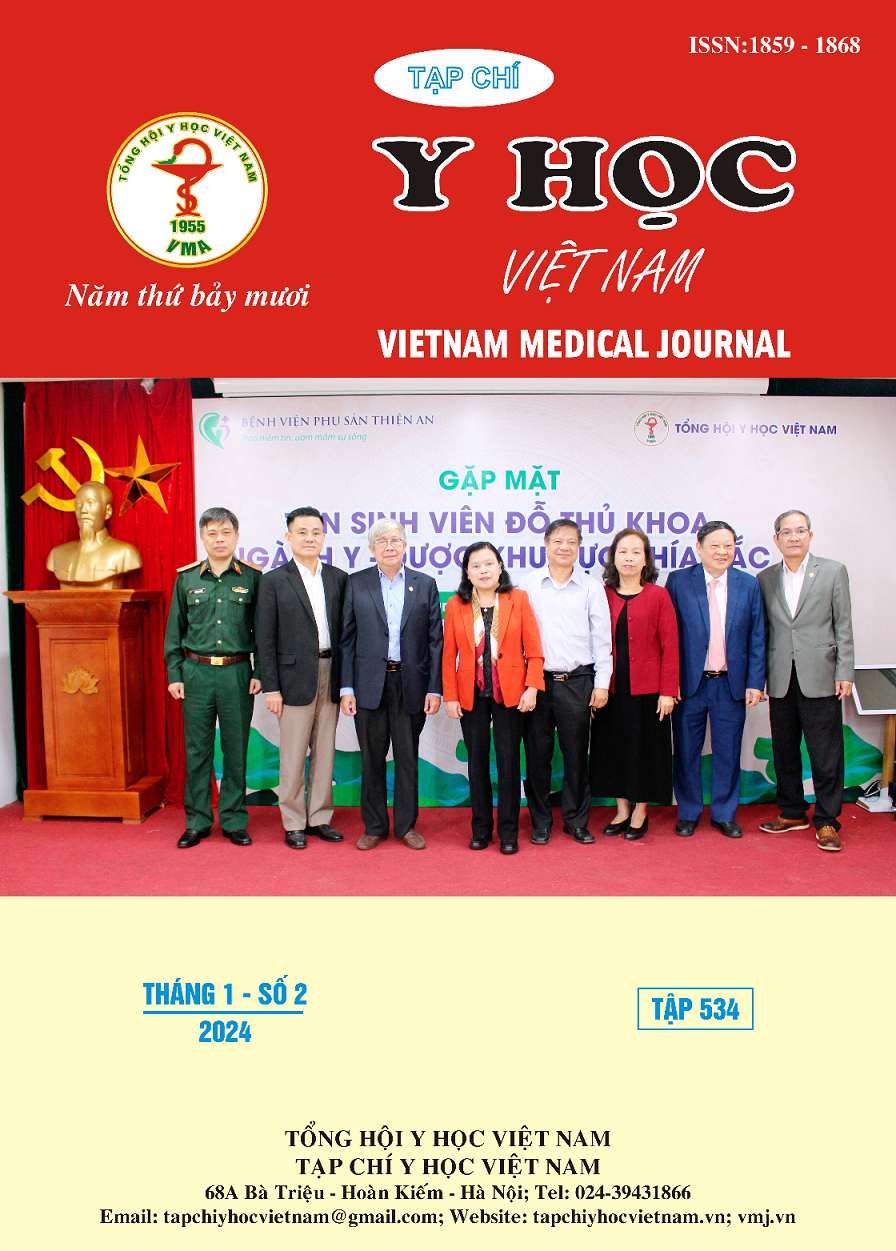KẾT QUẢ PHẪU THUẬT BẮC CẦU ĐIỀU TRỊ BỆNH ĐỘNG MẠCH CHI DƯỚI TẠI BỆNH VIỆN ĐẠI HỌC Y HÀ NỘI
Nội dung chính của bài viết
Tóm tắt
Mục tiêu nghiên cứu: Đánh giá kết quả sớm của phương pháp phẫu thuật bắc cầu điểu trị Bệnh động mạch chi dưới (BĐMCD) tại Bệnh viện Đại học Y Hà Nội từ tháng 1/2019 đến tháng 7/2023. Đối tượng và phương pháp nghiên cứu: Nghiên cứu mô tả cắt ngang, hồi cứu. Tất cả các bệnh nhân được chẩn đoán là BĐMCD được chỉ định điều trị bằng phương pháp phẫu thuật bắc cầu động mạch tại bệnh viện đại học Y Hà Nội từ tháng 1/2019 đến tháng 7/2023. Kết quả: Có 53 bệnh nhân trong nghiên cứu, có tuổi trung bình là 65.07 ± 8,1 tuổi. Bệnh nhân nam chiếm 87.5%. Bệnh nhân đến viện với triệu chứng đau cách hồi tương ứng với giai đoạn IIB là 26.8%, giai đoạn III là 41.1%, giai đoạn IV là 32,1%. Kèm theo nhiều bệnh lý nền như tăng huyết áp (85.7%), đái tháo đường (48.2%), tai biến mạch máu não cũ (10.7%). Tổn thương trên cận lâm sàng nhiều nhất ở tầng đùi khoeo (66.07%). Phẫu thuật tiến hành nhiều nhất là bắc cầu đùi - khoeo trên gối (41,1%). Vật liệu sử dụng làm cầu nối là Tĩnh mạch hiển (57.14%), mạch nhân tạo (42.86%). Thời gian phẫu thuật trung bình 143,04 ± 45,04 phút. Không trường hợp nào có biến chứng trong mổ. Thời gian nằm viện sau mổ trung bình là 10.41±7,11 ngày. Tỷ lệ biến chứng sớm sau mổ là 19.64%, phải mổ lại sớm là 12.5%. Không có bệnh nhân nào tử vong trong quá trình điều trị. Kết luận: Phẫu thuật bắc cầu hiện nay là phương pháp an toàn, mang lại hiệu quả cao trong điều trị Bệnh động mạch chi dưới tại Bệnh viện Đại học Y Hà nội.
Chi tiết bài viết
Tài liệu tham khảo
2. Song P, Rudan D, Zhu Y, et al. Global, regional, and national prevalence and risk factors for peripheral artery disease in 2015: an updated systematic review and analysis. Lancet Glob Health. 2019;7(8): e1020-e1030. doi: 10.1016/ S2214-109X(19)30255-4
3. Norgren L, Hiatt WR,, Dormandy JA. Inter-society consensus for the management of peripheral arterial disease [TASC II]. Dormandy JA. 2007.
4. Bhagirath VC, Nash D, Wan D, Anand SS. Building Your Peripheral Artery Disease Toolkit: Medical Management of Peripheral Artery Disease in 2022. Can J Cardiol. 2022;38(5): 634-644. doi:10.1016/ j.cjca.2022.02.004
5. Quế ĐK, Trung NA. Đánh Giá Kết Qủa Phẫu Thuật Phục Hồi Lưu Thông Động Mạch Chi Dưới. Tạp Chí Phẫu Thuật Tim Mạch Và Lồng Ngực Việt Nam. 2020;15(45-55).
6. Abdoli S, Katz S, Ochoa C. Long-Term Patency and Clinical Outcomes of Nitinol Stenting for Femoropopliteal Atherosclerotic Disease. Ann Vasc Surg. 2020;66: 566-572. doi: 10.1016/ j.avsg.2019.11.002
7. Ambler GK, Twine CP. Graft type for femoro-popliteal bypass surgery. Cochrane Vascular Group, ed. Cochrane Database Syst Rev. 2018; 2018(2). doi:10.1002/14651858.CD001487.pub3
8. Thịnh, C Văn. kết quả thực hiện phẫu thuật bắc cầu tại chỗ trong tắc động mạch mạn chi dưới bằng tĩnh mạch hiển có nội soi phá van tại bvnd 115. Tạp Chí Phẫu Thuật Tim Mạch Và Lồng Ngực Việt Nam. 2021;9:50-60.


